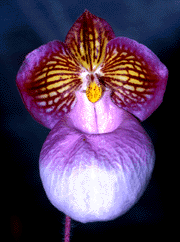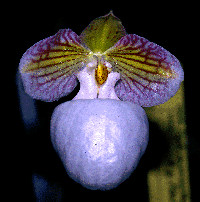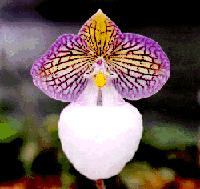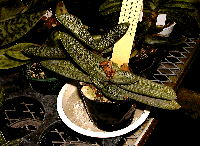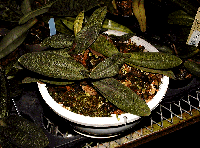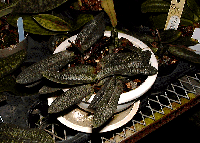Paph. micranthumvar micranthum |
|
|
@In 1940, Paph. micranthum was discovered near Maripoa in
china where is close to the border to Viet Nam. Although this
species was discovered earlier than we expected, J.Tang and F.C.Wangt
recorded in 1951 officially. It means the topics of the new species
in China was ignored for over 10 years. Further more, this record
was written by Chinese and nobody know about it. It was 1970
that we know the truth about Paph. micranthum and it is the same
time almost for the discovery of Paph. armeniacum. We were surprised
the new species , Paph. micranthum and armeniacum that are very
different shape and color from the Paphiopedilums that we know
before. The new species that are discovered in China, Yunnan
were similar to Paph. delenatii. Before, Paph. delenatii is one
of Brachypetalum like Paph. bellatulum and niveum but it is very
easy that we identify the new species containing Paph. delenatii
is very different from the species in Brachypetalum. So, Dr.
Karasawa and Saitoh made a new subgenus of parvisepalum. The
specific features of these new species is 1) Dorsal sepal is
smaller, 2) the pouch ( lip ) is very big lacking a balance,
3) the fluorescence is longer. When we see the flower, it is
valuable to observation for the good color and the bigger flower
than we expect from the p;ant size. (1) Paph. micranthum var micranthum (2) Paph. micranthum var marginatum (3) Paph. micranthum var extendatum (4)Paph. micranthum var eburneum |
| (5) Paph. micranthum var Guangxi@@ The variety was discovered after Paph. was prohibited to export and import by Washington Treaty. @Perhaps, they distributed in the southest area in China. The flower is whitish and the pouch is white. And the shape of pouch is not so large balloon but the pointed end. |
|
| NoteFIn truth, it is very difficult to identify these 5 varieties above critically. But from the color, size and shape, it will be easier to identify one group of Paph. micranthum var micranthum and Paph. micranthum var marginatum and another group of Paph. micranthum var extendatum and Paph. micranthum var eburneum. Because the former is pink flower with pink pouch especially and the latter's flower is whitish. |
| (6) Paph. micranthum var vietnamense @@ @This variety is the newest discovered variety from Viet Nam. The color f flower is whitish and the pouch is brilliant white. And the pink color on petal is very vivid. It is very similar variety to (5) Paph. micranthum var Guangxi. |
|
| Brief cultivation of
Paph. armeniacum @In nature, they grow under the severe climate but it looks like grow well in the better condition like in green house. But to flower, they have the different problems and it is not so easy to flower. For growing plant, it is 15 , the Min. tem in winter but don't forget about that the technique of flowering is very different from the technique of growing. The 50 % of shade is enough i the whole year. They don't need fertilize so much and we give a small amount of solid type of fertilize or the 2 ~5 times, final 4000~10000 times dilution, more diluted of liquid type fertilizer in regular dilution. For Paph. micruthum, they like crypt-moss or bark alone for the compost . But I recommend you to use the mix compost. They don't like sphagnum moss, I guess. When it grow satisfactorily, they will make a few young plants by spread new lysomes. But don't cut the to divide the younger plants. You had better keep the young plants at least one year until their having some roots their own. In order to make the bad of flower, it must be the lower temperature under 15 from in the late of autumn to the end of winter. If possible, it is better make under 10 . In this season, they will need not only the lower temperature but also the sun shine. We keep it in our mind to make them sunbathe i fine days. The temperature will be higher a little bit than that in case of Paph. armeniacum. |
|
|
Basically, I 'm using mix compost for Paph. micranthum. We van get the good result in case of crypt-moss for the compost too. They like water but we had better make it less than Paph. armeniacum. It should be a little bit.... |
|
|
|
